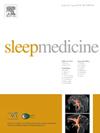Putamen dopaminergic dysfunction is associated with sleep disturbance in drug-naïve patients with Parkinson's disease
IF 3.8
2区 医学
Q1 CLINICAL NEUROLOGY
引用次数: 0
Abstract
Background
Sleep disturbance (SD) is common in Parkinson's disease (PD) and adversely affect the quality of life (QOL). Although dopamine dysfunction has been implicated, the specific role of dopaminergic activity in SD among patients with PD remains unclear. Given that dopamine-related medications can affect sleep, it is essential to assess SD in drug-naïve patients. This study investigated the association between SD and uptake of striatal dopamine transporters using Dopamine Transporter Single-Photon Emission Computed Tomography with 123I-Ioflupane (DAT-SPECT).
Methods
We retrospectively analyzed 112 drug-naïve patients through the PD Sleep Scale-version-2 (PDSS-2) and DAT-SPECT. Patients were divided into SD and non-SD groups using a PDSS-2 cut-off score of 15. The Mann-Whitney U test and binomial regression were used to compare the groups.
Results
SD was identified in 47.3 % of participants, correlating significantly with increased age, more severe motor symptoms, cognitive decline, depressive symptoms, and reduced QOL scores. Binomial regression analyses—adjusted for sex, age, motor dysfunction, cognitive function, and nocturnal autonomic cardiovascular dysfunction—showed that reduced DAT-SPECT uptake in the left anterior and posterior putamen significantly contributed to higher PDSS-2 scores.
Conclusion
This study demonstrated a link between SD and putamen DAT-SPECT uptake in drug-naïve patients with PD, indicating the role of dopamine in sleep regulation. These findings underscore the importance of managing SD in patients with PD to improve QOL and suggest the need for further investigation of the impact of dopaminergic dysfunction on sleep.
求助全文
约1分钟内获得全文
求助全文
来源期刊

Sleep medicine
医学-临床神经学
CiteScore
8.40
自引率
6.20%
发文量
1060
审稿时长
49 days
期刊介绍:
Sleep Medicine aims to be a journal no one involved in clinical sleep medicine can do without.
A journal primarily focussing on the human aspects of sleep, integrating the various disciplines that are involved in sleep medicine: neurology, clinical neurophysiology, internal medicine (particularly pulmonology and cardiology), psychology, psychiatry, sleep technology, pediatrics, neurosurgery, otorhinolaryngology, and dentistry.
The journal publishes the following types of articles: Reviews (also intended as a way to bridge the gap between basic sleep research and clinical relevance); Original Research Articles; Full-length articles; Brief communications; Controversies; Case reports; Letters to the Editor; Journal search and commentaries; Book reviews; Meeting announcements; Listing of relevant organisations plus web sites.
 求助内容:
求助内容: 应助结果提醒方式:
应助结果提醒方式:


